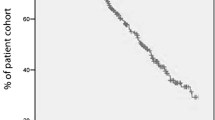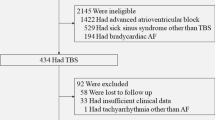Abstract
Introduction
The temporal patterns of onset of persistent atrial fibrillation (AF) recurrences leading to established persistent AF is currently unknown.
Methods
Three hundred thirty patients with a history of paroxysmal AF and bradycardia (mean age, 70 ± 10 years; 61% male) with implanted pacemakers that automatically recorded the cumulative daily atrial tachyarrhythmia (AT) burden were included in the analysis. Persistent AF was defined as device data showing ≥7 consecutive days with ≥23 h of AT. We analyzed the pattern and duration of persistent AF recurrences and time to each persistent AF episode recurrence.
Results
Seventy-eight patients (24%) developed their first persistent AT/AF after 147 ± 149 days. Follow up ranged from 14 to 499 days. Median AF burden in the week prior to persistent AF was 3.5 h/day. Fifty-four patients (16%) had a minimum of 180 days follow up after initial detection of persistent AF. Three of 54 patients (6%) immediately developed established AF; 32 of 51 patients (63%) returned to sinus rhythm but then had a second persistent AF event. These 32 patients had a minimum of 90 days follow up and 25 of these 32 patients (78 %) had a third persistent AF event. Time to recurrence analysis showed progressive abbreviation in persistent AF onset. The median durations of the first, second, and third persistent AF events were 16, 13, and 17 days, respectively.
Conclusions
(1) The time to first, second, and third persistent AF recurrences progressively decreases with a high likelihood of established persistent AF within 9 months of onset. (2) These data support intermittent but frequent AF monitoring for the detection of persistent AF recurrences to assess the efficacy of rhythm control interventions.





Similar content being viewed by others
References
Go, A. S., Hylek, E. M., Phillips, K. A., Chang, Y., Henault, L. E., Selby, J. V., et al. (2001). Prevalence of diagnosed atrial fibrillation in adults: national implications for rhythm management and stroke prevention: the AnTicoagulation and Risk Factors in Atrial Fibrillation (ATRIA) Study. JAMA, 285, 2370–2375.
Miyasaka, Y., Barnes, M. E., Gersh, B. J., Cha, S. S., Bailey, K. R., Abhayaratna, W. P., et al. (2006). Secular trends in incidence of atrial fibrillation in Olmsted County, Minnesota, 1980 to 2000, and implications on the projections for future prevalence. Circulation, 114, 119–125.
Camm, A. J., Kirchhof, P., Lip, G. Y., Schotten, U., Savelieva, I., Ernst, S., et al. (2010). Guidelines for the management of atrial fibrillation: the Task Force for the Management of Atrial Fibrillation of the European Society of Cardiology. Europace, 12(10), 1360–1420.
Camm, A. J., Levy, S., Saksena, S., & Wyse, D. G. (2000). Don't you agree, or what part of the problem don't you understand? Journal Intervent Card Electrophysiology, 2000(4), 559–560.
Strickberger, A., Ip, J., Saksena, S., Curry, K., Bahnson, T. D., & Ziegler, P. D. (2005). Relationship between atrial tachyarrhythmias and symptoms. Heart Rhythm, 2(2), 125–131.
Hindricks, G., Piorkowski, C., Tanner, H., Kobza, R., Gerds-Li, J., Carbucicchio, C., et al. (2005). Perception of atrial fibrillation before and after radiofrequency catheter ablation: relevance of asymptomatic arrhythmia recurrence. Circulation, 112(3), 307–313.
The Atrial Fibrillation Follow-up Investigation of Rhythm Management (AFFIRM) Investigators. (2002). A comparison of rate control and rhythm control in patients with atrial fibrillation. The New England Journal of Medicine, 347, 1825–1833.
Van Gelder, I. C., Hagens, V. E., Bosker, H. A., Kingma, J. H., Kamp, O., Kingma, T., et al. (2002). A comparison of rate control and rhythm control in patients with recurrent persistent atrial fibrillation. The New England Journal of Medicine, 347, 1834–1840.
Levy, S., Camm, A. J., Saksena, S., Breithardt, C. H. J., Davies, D. W., Kay, G. N., et al. (2003). International consensus on nomenclature and classification of atrial fibrillation: a collaborative project of the Working Group on Arrhythmias and the Working Group of Cardiac Pacing of the European Society of Cardiology and the North American Society of Pacing and Electrophysiology. Journal of Cardiovascular Electrophysiology, 14, 443–445.
Calkins, H., Brugada, J., Packer, D. L., Cappato, R., Chen, S. A., Crijns, H. J., et al. (2007). HRS/EHRA/ECAS expert Consensus Statement on catheter and surgical ablation of atrial fibrillation: recommendations for personnel, policy, procedures and follow-up. A report of the Heart Rhythm Society (HRS) Task Force on catheter and surgical ablation of atrial fibrillation developed in partnership with the European Heart Rhythm Association (EHRA); European Cardiac Arrhythmia Society (ECAS); American College of Cardiology (ACC); American Heart Association (AHA); Society of Thoracic Surgeons (STS). Heart Rhythm, 4(6), 816–861.
Saksena, S., Hettrick, D. A., Koehler, K. L., Grammatico, A., & Padeletti, L. (2007). Progression of paroxysmal atrial fibrillation to persistent atrial fibrillation in patients with bradyarrhythmias. American Heart Journal, 154, 884–892.
Padeletti, L., Pürerfellner, H., Adler, S. W., Waller, T. J., Harvey, M., Horvitz, L., et al. (2003). Combined efficacy of atrial septal lead placement and atrial pacing algorithms for prevention of paroxysmal atrial tachyarrhythmia. Journal of Cardiovascular Electrophysiology, 14, 1189–1195.
Purerfellner, H., Gillis, A. M., Holbrook, R., & Hettrick, D. A. (2004). Accuracy of atrial tachyarrhythmia detection in implantable devices with arrhythmia therapies. Pacing and Clinical Electrophysiology, 27, 983–992.
Inama, G., Santini, M., Padeletti, L., Boriani, G., Botto, G., Capucci, A., et al. (2004). Far-field R wave oversensing in dual chamber pacemakers designed for atrial arrhythmia management: effect of pacing site and lead tip to ring distance. Pacing and Clinical Electrophysiology, 27, 1221–1230.
Israel, C. W., Gronefeld, G., Ehrlich, J. R., Li, Y. G., & Hohnloser, S. H. (2004). Long-term risk of recurrent atrial fibrillation as documented by implantable monitoring device: implications for optimal patient care. Journal of the American College of Cardiology, 43, 47–52.
Ziegler, P. D., Koehler, J. L., & Mehra, R. (2006). Comparison of continuous versus intermittent monitoring of atrial arrhythmias. Heart Rhythm, 3(12), 1445–1452.
Willems, R., Wyse, D. G., Gillis, A. M., & for the Atrial Pacing Periablation for Paroxysmal Atrial Fibrillation (PA3) Study Investigators. (2003). Total atrioventricular nodal ablation increases atrial fibrillation burden in patients with paroxysmal atrial fibrillation despite continuation of antiarrhythmic drug therapy. Journal of Cardiovascular Electrophysiology, 14, 1296–1301.
Saksena, S., Skadsberg, N., Rao, H., & Filipecki, A. (2005). Biatrial and three-dimensional mapping of spontaneous atrial arrhythmias in patients with refractory atrial fibrillation. Journal of Cardiovascular Electrophysiology, 16(5), 494–504.
Saksena, S., & Skadsberg, N. (2008). Three-dimensional and biatrial mapping of atrial tachyarrhythmias in coronary and hypertensive heart disease: identifying mechanisms that initiate and maintain atrial fibrillation. Journal American Colleg Cardiology (Abstract), 51(10 Suppl A), A5.
Glotzer, T. V., Daoud, E. G., Wyse, D. G., Singer, D. E., Ezekowitz, M. D., Hilker, C., et al. (2009). The relationship between daily atrial tachyarrhythmia burden from implantable device diagnostics and stroke risk: the TRENDS study. Circulation Arrhythmia and Electrophysiology, 2(5), 474.
Pedersen, O. D., Bagger, H., Keller, N., Marchant, B., Køber, L., Torp-Pedersen, C., et al. (2001). Efficacy of dofetilide in the treatment of atrial fibrillation-flutter in patients with reduced left ventricular function: a Danish investigations of arrhythmia and mortality on dofetilide (diamond) substudy. Circulation, 104, 292–296.
Deedwania, P. C., Singh, B. N., Ellenbogen, K., Fisher, S., Fletcher, R., & Singh, S. N. (1998). Patients with heart failure and atrial fibrillation: observations from the Veterans Affairs Congestive Heart Failure Survival Trial of Antiarrhythmic Therapy (CHF-STAT). Circulation, 98, 2574–2579.
Singh, B. N., Singh, S. N., Reda, D., Tang, X. C., Lopez, B., Harris, C. L., et al. (2005). Amiodarone versus sotalol for atrial fibrillation. The New England Journal of Medicine, 352, 1861–1872.
Ahmed, S., Rienstra, M., Crijns, H. J., Links, T. P., Wiesfeld, A. C. P., Hillege, H. L., et al. (2008). Continuous vs episodic prophylactic treatment with amiodarone for the prevention of atrial fibrillation: a randomized trial. JAMA, 300(15), 1784–1792.
Madan, N., & Saksena, S. (2004). Long-term rhythm control of drug-refractory atrial fibrillation with "hybrid therapy" incorporating dual-site right atrial pacing, antiarrhythmic drugs, and right atrial ablation. The American Journal of Cardiology, 93, 569–575.
Matsuo, S., Lellouche, N., Wright, M., Bevilacqua, M., Knecht, S., Nault, I., et al. (2009). Clinical predictors of termination and clinical outcome of catheter ablation for persistent atrial fibrillation. Journal of the American College of Cardiology, 54(9), 788–795.
Financial disclosure
Dr. Nagarakanti has no conflict of interest. Dr. Saksena is a consultant for Medtronic Inc., Sanofi-Aventis, and St. Jude Inc. and receives research support from Sorin Inc., the National Heart Lung and Blood Institute, and Sanofi-Aventis, Inc. Dr. Padeletti is a consultant for and receives research support from Medtronic Inc. and St. Jude Medical Italia. Dr. Douglas Hettrick, Ms. Jodi Koehler, and Dr. Andrea Grammatico are employees of Medtronic Inc. This study has been solely supported by the Electrophysiology Research Foundation without external funding.
Author information
Authors and Affiliations
Corresponding author
Rights and permissions
About this article
Cite this article
Nagarakanti, R., Saksena, S., Hettrick, D. et al. Progression of new onset to established persistent atrial fibrillation: an implantable device-based analysis with implications for clinical classification of persistent atrial fibrillation. J Interv Card Electrophysiol 32, 7–15 (2011). https://doi.org/10.1007/s10840-011-9601-1
Received:
Accepted:
Published:
Issue Date:
DOI: https://doi.org/10.1007/s10840-011-9601-1




